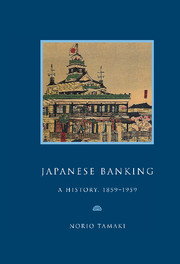Book contents
- Frontmatter
- Contents
- Preface
- Genealogy of leading Japanese banks, 1859–1959
- List of abbreviations
- Map
- Part I A bankrupt Shogunate, 1859–1868
- Historical background
- 1 Japanese merchant bankers: ryogae, 1859–1868
- 2 A bankrupt regime, 1859–1866
- 3 Ryogae struggling for survival, 1859–1868
- 4 The arrival of western banking, 1863–1868
- Part II The Meiji Restoration: monetary confusion and banking experiments, 1868–1881
- Part III Matsukata, the wizard of Japanese banking, 1881–1897; the Yokohama Specie Bank (1880) and the Bank of Japan (1882)
- Part IV The Japanese on the London money market, 1897–1911
- Part V War, the Japanese boom years, 1911–1919
- Part VI Crisis and the road to war, 1919–1937
- Part VII Complete commitment, struggle and defeat, 1937–1945
- Part VIII American ‘democratisation’ and the search for growth, 1945–1959
- An extraordinary century, 1859–1959
- Appendices
- Notes
- Bibliography
- Index
3 - Ryogae struggling for survival, 1859–1868
Published online by Cambridge University Press: 03 February 2010
- Frontmatter
- Contents
- Preface
- Genealogy of leading Japanese banks, 1859–1959
- List of abbreviations
- Map
- Part I A bankrupt Shogunate, 1859–1868
- Historical background
- 1 Japanese merchant bankers: ryogae, 1859–1868
- 2 A bankrupt regime, 1859–1866
- 3 Ryogae struggling for survival, 1859–1868
- 4 The arrival of western banking, 1863–1868
- Part II The Meiji Restoration: monetary confusion and banking experiments, 1868–1881
- Part III Matsukata, the wizard of Japanese banking, 1881–1897; the Yokohama Specie Bank (1880) and the Bank of Japan (1882)
- Part IV The Japanese on the London money market, 1897–1911
- Part V War, the Japanese boom years, 1911–1919
- Part VI Crisis and the road to war, 1919–1937
- Part VII Complete commitment, struggle and defeat, 1937–1945
- Part VIII American ‘democratisation’ and the search for growth, 1945–1959
- An extraordinary century, 1859–1959
- Appendices
- Notes
- Bibliography
- Index
Summary
Under the terms of the treaties of friendship, concluded between 1853 and 1856, the bakufu officials were required to handle foreign exchange business. The treaties engaged them to supply food, water, coal and other necessities to the western ships for which hard cash – Mexican dollars – should be the payment. The exchange rate was to be negotiated between the bakufu and the western representatives, and the business of supplying the necessities was to be done only under the strict supervision of the bakufu. The opening of three ports totally changed the situation. Trade was strictly confined to the three treaty ports from which the export of silk and tea started immediately. The most astonishing result was the outflow of gold from Japan. The bakufu financial experts did not understand that gold in Japan was, in relation to the rest of the world, too cheap.
In June 1859, a month before the opening of the ports, the parity of exchange between gold and silver was 1:6.44, gold being markedly undervalued compared with the internationally prevalent parity of 1:15. Despite this alarming situation, the bakufu financial authorities failed to respond and there was serious disagreement between the financial and foreign ministers. Western diplomats, including the British consul-general Rutherford Alcock, were alarmed and urged the bakufu officials to change the coinage. A large-scale recoinage was eventually carried out in the spring of 1860. In the mean time between 100,000 and 150,000 ryo of gold was drained overseas through the faulty exchange and this sum did not include gold lost through other channels.
- Type
- Chapter
- Information
- Japanese BankingA History, 1859–1959, pp. 13 - 16Publisher: Cambridge University PressPrint publication year: 1995

